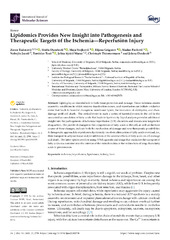Приказ основних података о документу
Lipidomics Provides New Insight into Pathogenesis and Therapeutic Targets of the Ischemia—Reperfusion Injury
| dc.creator | Todorović, Zoran | |
| dc.creator | Đurašević, Siniša | |
| dc.creator | Stojković, Maja | |
| dc.creator | Grigorov, Ilijana | |
| dc.creator | Pavlović, Slađan | |
| dc.creator | Jasnić, Nebojša | |
| dc.creator | Tosti, Tomislav | |
| dc.creator | Bjekić Macut, Jelica | |
| dc.creator | Thiemermann, Christoph | |
| dc.creator | Đorđević, Jelena | |
| dc.date.accessioned | 2021-03-12T11:22:33Z | |
| dc.date.available | 2021-03-12T11:22:33Z | |
| dc.date.issued | 2021 | |
| dc.identifier.issn | 1422-0067 | |
| dc.identifier.uri | https://www.mdpi.com/1422-0067/22/6/2798 | |
| dc.identifier.uri | https://radar.ibiss.bg.ac.rs/handle/123456789/4162 | |
| dc.description.abstract | Lipids play an essential role in both tissue protection and damage. Tissue ischemia creates anaerobic conditions in which enzyme inactivation occurs, and reperfusion can initiate oxidative stress that leads to harmful changes in membrane lipids, the formation of aldehydes, and chain damage until cell death. The critical event in such a series of harmful events in the cell is the unwanted accumulation of fatty acids that leads to lipotoxicity. Lipid analysis provides additional insight into the pathogenesis of ischemia/reperfusion (I/R) disorders and reveals new targets for drug action. The profile of changes in the composition of fatty acids in the cell, as well as the time course of these changes, indicate both the mechanism of damage and new therapeutic possibilities. A therapeutic approach to reperfusion lipotoxicity involves attenuation of fatty acids overload, i.e., their transport to adipose tissue and/or inhibition of the adverse effects of fatty acids on cell damage and death. The latter option involves using PPAR agonists and drugs that modulate the transport of fatty acids via carnitine into the interior of the mitochondria or the redirection of long-chain fatty acids to peroxisomes. | |
| dc.publisher | Multidisciplinary Digital Publishing Institute | |
| dc.relation | info:eu-repo/grantAgreement/MESTD/inst-2020/200007/RS// | |
| dc.relation | info:eu-repo/grantAgreement/MESTD/inst-2020/200110/RS// | |
| dc.relation | info:eu-repo/grantAgreement/MESTD/inst-2020/200178/RS// | |
| dc.relation | info:eu-repo/grantAgreement/MESTD/inst-2020/200168/RS// | |
| dc.relation | COST Action CA19105 | |
| dc.rights | openAccess | |
| dc.rights.uri | https://creativecommons.org/licenses/by/4.0/ | |
| dc.source | International Journal of Molecular Sciences | |
| dc.subject | Ischemia/reperfusion | |
| dc.subject | Kidney | |
| dc.subject | Lipidomics | |
| dc.subject | Liver | |
| dc.title | Lipidomics Provides New Insight into Pathogenesis and Therapeutic Targets of the Ischemia—Reperfusion Injury | |
| dc.type | article | en |
| dc.rights.license | BY | |
| dcterms.abstract | Тхиемерманн, Цхристопх; Јаснић, Небојша; Григоров, Илијана; Тости, Томислав; Павловић, Слађан; Стојковић, Маја; Ђурашевић, Синиша; Тодоровић, Зоран; Ђорђевић, Јелена; Бјекић Мацут, Јелица; | |
| dc.rights.holder | © 2021 by the authors. Licensee MDPI, Basel, Switzerland. | |
| dc.citation.issue | 6 | |
| dc.citation.volume | 22 | |
| dc.identifier.doi | 10.3390/ijms22062798 | |
| dc.identifier.wos | 000645716600001 | |
| dc.citation.apa | Todorović, Z., Đurašević, S., Stojković, M., Grigorov, I., Pavlović, S., Jasnić, N., et al. (2021). Lipidomics Provides New Insight into Pathogenesis and Therapeutic Targets of the Ischemia—Reperfusion Injury. International Journal of Molecular Sciences, 22(6), 2798. | |
| dc.citation.vancouver | Todorović Z, Đurašević S, Stojković M, Grigorov I, Pavlović S, Jasnić N, Tosti T, Macut JB, Thiemermann C, Đorđević J. Lipidomics Provides New Insight into Pathogenesis and Therapeutic Targets of the Ischemia—Reperfusion Injury. Int J Mol Sci. 2021;22(6):2798. | |
| dc.citation.spage | 2798 | |
| dc.type.version | publishedVersion | |
| dc.identifier.fulltext | https://radar.ibiss.bg.ac.rs/bitstream/id/8264/ijms-22-02798.pdf | |
| dc.citation.rank | M21 |

